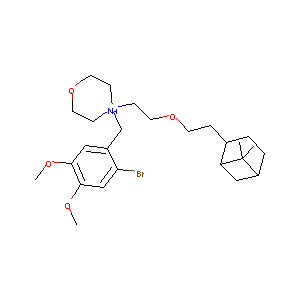Drug Information
| Drug General Information | Top | |||
|---|---|---|---|---|
| Drug ID |
D0J1NQ
|
|||
| Former ID |
DCL000931
|
|||
| Drug Name |
Pinaverium bromide
|
|||
| Synonyms |
Dicetel; Bromure de pinaverium; Bromuro de pinaverio; Pinaverii bromidum; Pinaverium bromide [INN]; LAT 1717; Bromure de pinaverium [INN-French]; Bromuro de pinaverio [INN-Spanish]; Dicetel (TN); Pinaverii bromidum [INN-Latin]; Pinaverium bromide (INN); Morpholinium, 4-(2-bromo-4,5-dimethoxy)benzyl-4-(2-(2-(6,6-dimethyl-2-norpinyl)ethoxy)ethyl)-, bromide; 4-(6-Bromoveratryl)-4-(2-(2-(6,6-dimethyl-2-norpinyl)ethoxy)ethyl)morpholinium bromide; 4-[(2-bromo-4,5-dimethoxyphenyl)methyl]-4-[2-[2-(6,6-dimethyl-4-bicyclo[3.1.1]heptanyl)ethoxy]ethyl]morpholin-4-ium bromide
Click to Show/Hide
|
|||
| Drug Type |
Small molecular drug
|
|||
| Indication | Irritable bowel syndrome [ICD-11: DD91.0; ICD-10: K55-K64, K58; ICD-9: 564.1, 787.91] | Phase 3 | [1] | |
| Company |
Solvay
|
|||
| Structure |
 |
Download2D MOL |
||
| Formula |
C26H41Br2NO4
|
|||
| Canonical SMILES |
CC1(C2CCC(C1C2)CCOCC[N+]3(CCOCC3)CC4=CC(=C(C=C4Br)OC)OC)C.[Br-]
|
|||
| InChI |
1S/C26H41BrNO4.BrH/c1-26(2)21-6-5-19(22(26)16-21)7-11-31-12-8-28(9-13-32-14-10-28)18-20-15-24(29-3)25(30-4)17-23(20)27;/h15,17,19,21-22H,5-14,16,18H2,1-4H3;1H/q+1;/p-1
|
|||
| InChIKey |
IKGXLCMLVINENI-UHFFFAOYSA-M
|
|||
| CAS Number |
CAS 53251-94-8
|
|||
| PubChem Compound ID | ||||
| PubChem Substance ID | ||||
| ADReCS Drug ID | BADD_D01775 | |||
| SuperDrug ATC ID |
A03AX04
|
|||
| Interaction between the Drug and Microbe | Top | |||
|---|---|---|---|---|
| The Abundace of Studied Microbe(s) Regulated by Drug | ||||
| The Order in the Taxonomic Hierarchy of the following Microbe(s): Bacteroidales | ||||
|
Studied Microbe: Bacteroides vulgatus
Show/Hide Hierarchy
|
[2] | |||
| Hierarchy | ||||
| Abundance Change | Decrease | |||
| Experiment Method | High-throughput screening | |||
| Description | The abundance of Bacteroides vulgatus was decreased by Pinaverium bromide (adjusted p-values: 9.57E-05). | |||
| The Order in the Taxonomic Hierarchy of the following Microbe(s): Bifidobacteriales | ||||
|
Studied Microbe: Bifidobacterium longum
Show/Hide Hierarchy
|
[2] | |||
| Hierarchy | ||||
| Abundance Change | Decrease | |||
| Experiment Method | High-throughput screening | |||
| Description | The abundance of Bifidobacterium longum was decreased by Pinaverium bromide (adjusted p-values: 8.18E-03). | |||
| The Order in the Taxonomic Hierarchy of the following Microbe(s): Eubacteriales | ||||
|
Studied Microbe: Blautia obeum
Show/Hide Hierarchy
|
[2] | |||
| Hierarchy | ||||
| Abundance Change | Decrease | |||
| Experiment Method | High-throughput screening | |||
| Description | The abundance of Blautia obeum was decreased by Pinaverium bromide (adjusted p-values: 6.97E-06). | |||
|
Studied Microbe: Dorea formicigenerans
Show/Hide Hierarchy
|
[2] | |||
| Hierarchy | ||||
| Abundance Change | Decrease | |||
| Experiment Method | High-throughput screening | |||
| Description | The abundance of Dorea formicigenerans was decreased by Pinaverium bromide (adjusted p-values: 5.40E-03). | |||
|
Studied Microbe: Eubacterium eligens
Show/Hide Hierarchy
|
[2] | |||
| Hierarchy | ||||
| Abundance Change | Decrease | |||
| Experiment Method | High-throughput screening | |||
| Description | The abundance of Eubacterium eligens was decreased by Pinaverium bromide (adjusted p-values: 9.20E-04). | |||
|
Studied Microbe: Eubacterium rectale
Show/Hide Hierarchy
|
[2] | |||
| Hierarchy | ||||
| Abundance Change | Decrease | |||
| Experiment Method | High-throughput screening | |||
| Description | The abundance of Eubacterium rectale was decreased by Pinaverium bromide (adjusted p-values: 2.94E-04). | |||
|
Studied Microbe: Roseburia hominis
Show/Hide Hierarchy
|
[2] | |||
| Hierarchy | ||||
| Abundance Change | Decrease | |||
| Experiment Method | High-throughput screening | |||
| Description | The abundance of Roseburia hominis was decreased by Pinaverium bromide (adjusted p-values: 8.08E-05). | |||
|
Studied Microbe: Roseburia intestinalis
Show/Hide Hierarchy
|
[2] | |||
| Hierarchy | ||||
| Abundance Change | Decrease | |||
| Experiment Method | High-throughput screening | |||
| Description | The abundance of Roseburia intestinalis was decreased by Pinaverium bromide (adjusted p-values: 1.52E-04). | |||
|
Studied Microbe: Ruminococcus torques
Show/Hide Hierarchy
|
[2] | |||
| Hierarchy | ||||
| Abundance Change | Decrease | |||
| Experiment Method | High-throughput screening | |||
| Description | The abundance of Ruminococcus torques was decreased by Pinaverium bromide (adjusted p-values: 2.56E-03). | |||
| The Order in the Taxonomic Hierarchy of the following Microbe(s): Veillonellales | ||||
|
Studied Microbe: Veillonella parvula
Show/Hide Hierarchy
|
[2] | |||
| Hierarchy | ||||
| Abundance Change | Decrease | |||
| Experiment Method | High-throughput screening | |||
| Description | The abundance of Veillonella parvula was decreased by Pinaverium bromide (adjusted p-values: 5.04E-06). | |||
| Target and Pathway | Top | |||
|---|---|---|---|---|
| Target(s) | Voltage-gated L-type calcium channel (L-CaC) | Target Info | Blocker | [1] |
| References | Top | |||
|---|---|---|---|---|
| REF 1 | Emerging drugs for irritable bowel syndrome. Expert Opin Emerg Drugs. 2006 May;11(2):293-313. | |||
| REF 2 | Extensive impact of non-antibiotic drugs on human gut bacteria. Nature. 2018 Mar 29;555(7698):623-628. | |||
If You Find Any Error in Data or Bug in Web Service, Please Kindly Report It to Dr. Zhou and Dr. Zhang.

